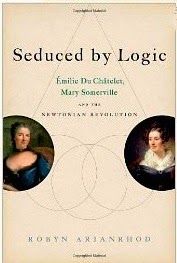Seduced by Logic : Emilie du Chatelet, Mary Somerville and the Newtonian Revolution

University of Queensland Press, 2011, 352 pp.
There can be no doubt in the 21st century about the power of mathematical physics to transform our material existence.
The atomic bomb, television and mobile phone are among its many offspring.
Robyn Arianrhod’s Seduced by Logic opens in 1706, at the dawn of the age of modern science and mathematical physics. In that year the little celebrated French mathematician Emilie du Chatelet was born, 19 years after Isaac Newton published Principia Mathematica, which set out his revolutionary theory of gravity and established the discipline of theoretical physics.
Du Chatelet was among the few in Europe who understood the significance of Newton’s work and she became one of the Principia’s earliest champions and interpreters. In the 1740s she made the first and still most comprehensive French translation of Newton’s 510-page Latin original.
Born some 70 years after du Chatelet, the equally overlooked Scottish mathematician Mary Somerville would further elucidate Newton and become a world authority on his mathematical physics.
Somerville translated into English the first two volumes of the five-volume Celestial Mechanics by Newton’s French disciple Pierre-Simon Laplace, a work of such complexity that it was understood by a mere handful of men in Britain. On its publication in 1831 Somerville’s translation became the standard text for higher astronomy at Cambridge University and would remain so for the next 100 years.
And yet Somerville herself, as a woman, was not permitted to study at Cambridge. Like du Chatelet, she was not free to pursue the flights of her intellect unhindered. Instead, she squeezed her mathematics into the cracks between her domestic duties.
She wrote: “I rose early and made such arrangements with regard to my children and family affairs that I had time to write afterwards, not however without many interruptions. A man can always command his time under the plea of business, a woman has no such excuse.”
Set in the wake of Newton’s revolutionary discoveries, Seduced by Logic recounts the hard work that such conceptual and intellectual breakthroughs leave behind: the teasing out of the implications of the equations, their proving through experiment, the overcoming of scepticism and resistance to new ideas.
In short, the enormous labour that goes into interpreting and disseminating a new scientific theory. This is the work that du Chatelet and Somerville did on the physics of Newton.
Arianrhod’s brilliant first book, Einstein’s Heroes (2003), focused on the life of Somerville’s much younger contemporary James Clerk Maxwell, whose theory of electromagnetism was published in 1873 and inspired Einstein. But it was ultimately a book about ideas: about how physicists name and imagine the world through the language of mathematics.
Similarly, while Seduced by Logic centres on the lives of du Chatelet and Somerville, it is ultimately about mathematics and its relation to physics and philosophy.
Through the fascinating, challenging and very different lives of these two women (du Chatelet was a wealthy aristocrat by birth and marriage who became Voltaire’s lover; Somerville grew up in genteel poverty and married a doctor), Arianrhod elucidates the mathematical, scientific and philosophical ideas that “seduced” them both.
Unlike Einstein’s Heroes, Seduced by Logic is not driven by the thrill of a quest for an ultimate solution such as Maxwell’s. But in its place is the compelling story of two under-regarded women determined against astonishing odds — primarily systemic discrimination against women in general and thinking women in particular — to learn mathematics and contribute to the field.
In Somerville’s day intellectual study was considered unnatural for women and damaging to their health. When her father discovered Mary’s secret interest in geometry and algebra he said: “We must put a stop to this, or we shall have Mary in a straitjacket one of these days.”
Although women were permitted to attend classes at Oxford and Cambridge by the late 19th century, they were not granted full degrees at either university until well into the 20th. In our own time Arianrhod struggled to become a mathematician, but now works with the equations of Einstein and Maxwell at Monash University in Melbourne.
It is impossible not to be caught up in Arianrhod’s enthusiasm for her subject and I was gripped from the first page. Seduced by Logic is an important book for two reasons: first, because it clearly demonstrates the historically contingent nature of science, this discipline which so potently directs human life on earth.
It shows in rich detail how revolutionary scientific theoretical breakthroughs — Newton’s, Maxwell’s, Einstein’s — are followed by decades of slow accretion of experimental proof and theoretical interpretation.
Second it reveals the staggering extent to which this activity has been conducted until recently to the exclusion of one half of the world’s people: women. Arianrhod’s second book deserves to be as widely read as her first.
Jane Gleeson-White.
He is a Sydney-based writer, reviewer and author of Australian Classics: 50 Great Writers and their Celebrated Works.
(Reproduced with permission from The Australian, “Female pioneers in mathematics found strength in numbers”, July 23, 2011)
Source:- Asia Pacific Mathematics Newsletter, Volume 1 No. 4 (October 2011).
It has been republished here with a special permission from World Scientific.
